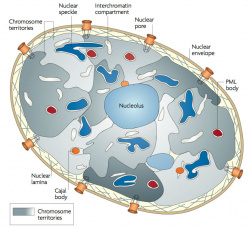Genetics - Chromosome 13
Introduction
Trisomy 13 (Patau syndrome) is a rare (1 in 10,000 newborns) developmental genetic abnormality (aneuploidy) with three copies of chromosome 13, instead of the usual two copies, there can also be a chromosomal translocation. Infant may have a single placental artery at birth.
- Links: Trisomy 13

|

|
| Chromosome territories (interphase) | Chromosome (Chromatin) structure (mitosis) |
| Human Chromosomes: 1 | 2 | 3 | 4 | 5 | 6 | 7 | 8 | 9 | 10 | 11 | 12 | 13 | 14 | 15 | 16 | 17 | 18 | 19 | 20 | 21 | 22 | X | Y |
Some Recent Findings
|
| More recent papers |
|---|
|
This table allows an automated computer search of the external PubMed database using the listed "Search term" text link.
More? References | Discussion Page | Journal Searches | 2019 References | 2020 References Search term: Chromosome 13 development | Chromosome 13 |
Development Genes
FGF
| Table - Human Fgf Family | ||||
| Approved Symbol |
Approved Name | Previous Symbols |
Synonyms | Chromosome |
|---|---|---|---|---|
| FGF9 | fibroblast growth factor 9 | 13q12.11 | ||
| Links: Developmental Signals - Fibroblast Growth Factor | OMIM Fgf1 | HGNC | ||||
SOX
| Table - Human Sox Family | ||||
| Approved Symbol |
Approved Name | Previous Symbols | Synonyms | Chromosome |
|---|---|---|---|---|
| SOX1 | SRY-box 1 | 13q34 | ||
| SOX21 | SRY-box 21 | SOX25 | 13q32.1 | |
| Links: Developmental Signals - Sox | OMIM | HGNC | | ||||
Abnormalities
In 1994, two breast cancer susceptibility genes were identified BRCA1 on chromosome 17 and BRCA2 on chromosome 13.
External Links
External Links Notice - The dynamic nature of the internet may mean that some of these listed links may no longer function. If the link no longer works search the web with the link text or name. Links to any external commercial sites are provided for information purposes only and should never be considered an endorsement. UNSW Embryology is provided as an educational resource with no clinical information or commercial affiliation.
| |
| Idiogram Chromosome Banding - The term refers to the light and dark pattern, seen after staining with a dye, of individual chromosomes identified in metaphase. It is only in meiosis and mitosis during metaphase that chromosomes can be easily identified, during the normal cell life (interphase) the chromosomes are unravelled and distributed within the nucleus in chromosome territories. A band is that part of a chromosome which is clearly distinguishable from nearby regions by appearing darker or brighter with one or more banding techniques. | |
| Genetic abnormality locations: 1-4 | 5-8 | 9-12 | 13-16 | 17-20 | 21-XY | sSMC | |
| |
| Links: Genetics | Abnormal Development - Genetic |
Cite this page: Hill, M.A. (2024, April 28) Embryology Genetics - Chromosome 13. Retrieved from https://embryology.med.unsw.edu.au/embryology/index.php/Genetics_-_Chromosome_13
- © Dr Mark Hill 2024, UNSW Embryology ISBN: 978 0 7334 2609 4 - UNSW CRICOS Provider Code No. 00098G
Cite this page: Hill, M.A. (2024, April 28) Embryology Genetics - Chromosome 13. Retrieved from https://embryology.med.unsw.edu.au/embryology/index.php/Genetics_-_Chromosome_13
- © Dr Mark Hill 2024, UNSW Embryology ISBN: 978 0 7334 2609 4 - UNSW CRICOS Provider Code No. 00098G
- ↑ Liu Y, Chen X, Gong Z, Zhang H, Fei F, Tang X, Wang J, Xu P, Zarbl H & Ren X. (2019). Fry Is Required for Mammary Gland Development During Pregnant Periods and Affects the Morphology and Growth of Breast Cancer Cells. Front Oncol , 9, 1279. PMID: 31824855 DOI.
- ↑ Çakmaklı S, Çankaya T, Gürsoy S, Koç A, Kırbıyık Ö, Kılıçarslan ÖA, Özer E, Erçal D & Bozkaya ÖG. (2017). Two Cases with Ring Chromosome 13 at either End of the Phenotypic Spectrum. Cytogenet. Genome Res. , 153, 175-180. PMID: 29518772 DOI.
